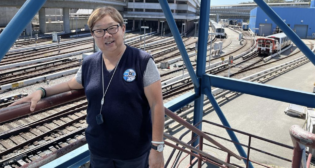
Regional Railroad of the Year: Arkansas & Missouri
Written by William C. Vantuono, Editor-in-ChiefArkansas & Missouri Railroad may not be a Class I rail leviathan. But when it comes to infrastructure, it’s a class act, ramping up for a bigger and brighter future.
Springdale, Ark.-based Arkansas & Missouri (A&M), founded in 1986, operates on 140 miles of track, 134 of those miles its main line from southwestern Missouri through western Arkansas; with its Fort Smith, Ark., operations flirting with the Oklahoma border. That mileage is protected by continuous welded rail, rated at 286,000 pounds GRL, cleared for speeds of 49 mph and, unlike perhaps many smaller railroads, cleared for doublestack container traffic.
The railroad’s equipment is equally up to date. A&M typically rosters 500 freight cars and, in 2013, acquired three EMD SD70AC3 locomotives to handle its growing business.
Spurred by $23 million in such investments during 2013 and continuing into this year, A&M, in the words of Chairman Reilly McCarren, is intent on “upping its game,” as it has for 27 years, as it continues “to introduce new companies to the business-friendly environment of Northwest Arkansas and southwestern Missouri,” part of what McCarren describes as “a regional transportation enterprise.”
Such can-do determination, backed by solid capital investment and a vision of truly regional scope, earns A&M Railway Age’s 2014 Regional Railroad of the Year award.
Home turf intermodal opportunities
A&M interchanges traffic with three Class I railroads—BNSF, Kansas City Southern, and Union Pacific—as well as the Fort Smith Railroad. It’s good and reliable business, with good business partnerships.
 But A&M isn’t just a feeder or distributor functionary; the railroad is growing its own customer base. “Together with its sister company Allied Enterprises, [A&M has] transformed itself from a typical leased property startup in 1986, relying exclusively on handling traffic for its Class I connections,” McCarren says. In 2014, A&M has evolved into an operation “featuring facilities that allow it to handle traffic that originates or terminates far from the rail line, and also handles significant volumes that move locally on the A&M’s line – either solely by rail or multimodally by rail and truck.”
But A&M isn’t just a feeder or distributor functionary; the railroad is growing its own customer base. “Together with its sister company Allied Enterprises, [A&M has] transformed itself from a typical leased property startup in 1986, relying exclusively on handling traffic for its Class I connections,” McCarren says. In 2014, A&M has evolved into an operation “featuring facilities that allow it to handle traffic that originates or terminates far from the rail line, and also handles significant volumes that move locally on the A&M’s line – either solely by rail or multimodally by rail and truck.”
Expanding intermodal capabilities are taking hold on A&M in numerous ways. In Fort Smith, on the southern end of A&M turf, the transloading and warehousing activities of sister company Allied Enterprises, doing business as Ozark Transmodal, Inc., now encompass seven acres of outside storage and 100,000 feet of warehouse space, which not only provides storage for commodities such as paper, steel, and forest products, but also packaging and blending capability for plastic resins.
“Overall, the facility handles almost 800 carloads annually spread between 20 different commodities,” McCarren says.
Ozark Transmodal also expanded its operational schedule in 2012 from five days a week to seven days, with two shifts, resulting in increased staff, as well, to ensure continued customer satisfaction, according to Ozark Transmodal Inc. Manager Bob Thorn.
Other commodities contribute
A&M’s customer base, of course, extends beyond intermodal business. Across the Arkansas River from Fort Smith, in Van Buren, Ark., company crews load the railroad’s fleet of cars with construction sand from a batch hopper at the Arkhola division of APAC Central. McCarren notes A&M loaded 10,600 cars in 2006, at the height of the building boom, before the Great Recession took its toll; about 6,600 carloads were generated in 2013 as the business slowly recovers.
Much of this business is local. “These cars move in regular freight train service to 14 different receivers on the A&M,” McCarren notes. “With rare exception, the cars are unloaded by the train crews themselves, providing a rapid return of the air-operated cars for further loads. It is typical to turn cars twice weekly, and thrice-weekly is possible during periods of high demand.”
Further north, in northwest Arkansas, A&M serves numerous poultry mills, freezer warehouses, food producers, and plastics processors. At least one of them is a national heavyweight known to millions: Tyson Foods, like A&M headquartered in Springdale, Ark., and tapping the railroad for reliable supplies of corn, mash, and gluten.
“In addition, northwest Arkansas has spawned a healthy metal recycling industry in the last few years as well,” McCarren says. Here, the activity is “all conventional railroading, with road switch crews, either two-person conventional crews or single-person engineer-only crews for delivery and spotting the industries, and coordinating with the road freights north and south.”
McCarren is especially proud of innovative service offered by A&M to one customer, a George’s Inc. feed mill in Cassville, Mo. “A&M frequently terminates 110-car-plus shuttles from BNSF at this location,” says McCarren, “but with a catch. George’s continues to operate its original, smaller feed mill in Springdale, Ark. Many trains feature a ‘split’; A&M power and crew will meet the train from the BNSF and hustle the requisite number of cars down to Springdale, spotting on arrival.
“With close coordination between railroad and feed mill, as many as 30 cars can be unloaded while still delivering the entire train back to interchange on time,” McCarren notes proudly. “It’s a rare railroad that operates express chicken feed trains, but A&M does what it takes to keep the customer happy—and using the rail mode.”
“Customer satisfaction” may be a trite phrase, but it matters, McCarren says. In the company’s March 2013 in-house newsletter, A&M Express, the chairman said, “It’s important to note that we ourselves can’t create the need for transportation. The demand for our services derives solely from our customers’ economic activities. What we can do is provide the best service possible so that existing and prospective customers choose us to handle their traffic. That service is the only product we have to sell. Second only to safety, service quality represents our most important goal.”
Shops keep railroad running
If quality depends on reliability, A&M has prepared itself well. Its headquarters city, Springdale, also includes the railroad’s passenger and mechanical facilities. (A&M’s passenger excursion consist features a Vista-Dome, the ex-California Zephyr Silver Feather.) The new locomotive shop, completed in 2012, includes a five-ton and 30-ton overhead traveling crane, one through track for quick service capability, and two stub-end tracks for equipment requiring significant time in the shop.
Nearly complete, says McCarren, “is a new ‘one-spot’ car repair facility that will bring car repair and locomotive repair forces together for the first time.” Nearby is a track equipment shop for the rebuilding and renewal of the work equipment fleet.
With the pieces in place for maintaining equipment to run the service to please the customers, McCarren cautiously foresees another good year ahead for A&M, in part because “we remain committed to investment in our facilities and equipment.”
With the Great Recession still a recent memory, the chairman is aware that nothing is guaranteed. “In 2009 the one-two punch of the recession and the Renewable Fuels Act reduced overall volumes by 40% in one year,” McCarren recalls. Still, “While volumes still haven’t recovered to 2008 levels, extra focus on marketing and improved traffic mix brought revenue and financial performance to record levels in 2013.”
The goal of “upping its game” remains in place, as it has for 27 years. Arkansas & Missouri has made it clear it knows its own role in the regional economy, and plans to keep delivering for at least another 27 years.



